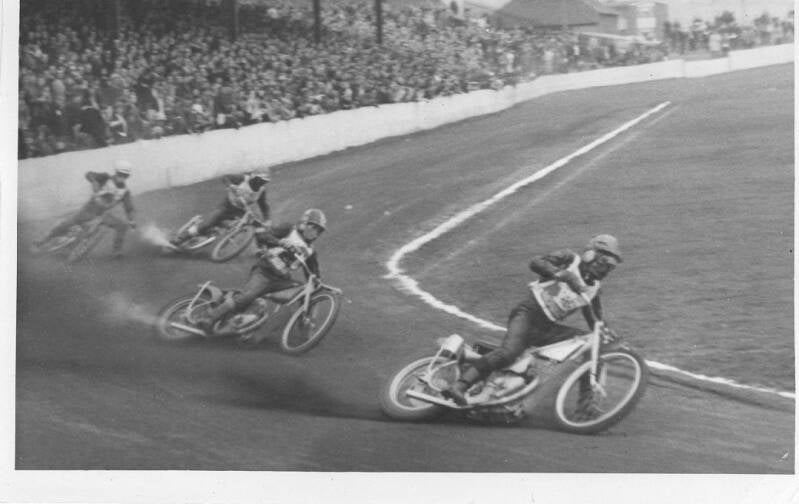Oyvind Berg - Hampdens Most Loved Tiger?

Coatbridge's George Hunter leads Jim McMillan and Oyvind Berg both Glasgow and Bert Harkins at Cliftonhill
Doug Nicolson looks at the career of the sometimes overlooked but much loved Oyvind Berg in
Oyvind Berg – Hampden’s most popular Tiger?
Ian Hoskins discovered Oyvind Berg when in Norway to discuss terms for 1967 with Reidar Eide. He was certainly fortunate that the BSPA agreed to him having three foreigners in his Monarchs team that year. Twenty three year old Berg made a big impression in his first meeting, the restaging of the 1966 Scottish Open, scoring ten points. However it was Bill Landels who made the headlines with a sensational win and Oyvind’s performance tended to get overlooked in match reports. He followed this up with solid scores throughout April, though still a bit raw he tended to have a few spills and gave a memorable quote saying it was “alright if I only hurt head, no break bones”, certainly a practical way of looking at things.
He continued to be a steady scorer as Monarchs league campaign gathered momentum as they eventually finished fourth, the highest placing by a Scottish team in the top division. However it was his 13+1 in the Scottish Cup at The White City that finally grabbed the headlines as Monarchs won 50-46 on the night and by a whopping 106-85 on aggregate, taking the Cup back to the east for the first time in three years. His performance was also noted by promoters Hoskins and Taylor as he would move through to join the Tigers for 1968. In the closing weeks he certainly gave the Monarchs plenty to remember him by, including a maiden paid maximum against Wimbledon; another double figure score in a challenge meeting at Glasgow and winning the Scottish Best Pairs with Wayne Briggs. The latter was the last ever meeting at Old Meadowbank and his win was rather lost in the emotion of the night.
White City
Charlie Monk had secured his requested transfer from Glasgow as did Alf Wells while Maury Mattingley was another to leave ahead of the 1968 season. The Tigers got a really shabby deal from the Rider Allocation Committee and received Oyvind and Lars Jansson as replacements. Had it not been for the meteoric rise of Jim McMillan then it is quite likely that the Tigers would have sunk without trace that year, although this tends to understate the role Oyvind played in the Tigers survival. After a comparatively quiet start he got in the groove and his swoops into the third bend at the Paisley Road track were the stuff of legend. He was in particularly good form as the season drew to a close, with a Last Six average of over 11.00 as he outscored Jimmy Mac in the final weeks, again something that was lost when Jim’s selection for the GB team to tour Australia was announced. The White City was very much Oyvinds track and his going there was a shrewd move by Hoskins.
Hampden
Hoskins pulled off another masterstroke by persuading Queens Park FC to let the Tigers move to Hampden, pre-empting them losing their White City home to the M8 Western Extension. With Charlie Monk returning to the Tigers fold they boasted their strongest ever heat leader trio of Monk, McMillan and Berg and things looked rosy for the Tigers in sharp contrast to the woes for the preceding year. However things didn’t quite go to plan. Alf Wells never settled at the Mount Florida circuit and went into a downward loss of form loss of confidence that saw him retire by mid summer after losing his team place. The big things widely predicted for Berg didn’t materialise as expected. Never the greatest of gaters, he found coming from the back far more difficult than at The White City, a blast around the boards could easily be blocked by the rider ahead drifting out while a cut back was often impossible due to the narrow exit from the bends. Despite this, he took his average to over 8.00, pretty good by any standards but some way behind Monk and McMillan and top scored for Norway against Scotland at Hampden.
It was more of the same in 1970, the year the Monarchs licence moved to Wembley, leaving Tigers the only team in Scotland and out on a limb with Belle Vue their nearest opponents over 200 miles away. While McMillan went on the greater things both Monk and Berg began to tread water as their scores plateaued. Oyvind had a rare moment of individual glory winning the Glasgow round of the Northern Riders Championship, something that was rapturously received by the Hampden crowd. He was probably the most loved Tiger of the time.
It was a pity that, for a rider who rarely missed a meeting through injury, he finished his Tigers career on the sidelines after breaking his collarbone at Sheffield causing him to miss the last half dozen Tigers meetings. He was fit in time to join the largely Scottish based party who spent the winter riding in Rhodesia. While he was enjoying the sunshine Tigers fans were fretting over rumours that he was seeking a transfer to a club where he could be their number one and get more open bookings.
Sadly these rumours proved to be true, and he joined Oxford. Glasgow had lost their most loved hero and for some, myself included, speedway at Hampden was never quite the same.
Oyvind had a couple of years at Oxford before returning to his native Norway but I’m sure his heart was still at The White City.

Oyvind Berg chasing Wolves Mick Handley and Bengt Andersson along with partner Alf Wells
Create Your Own Website With Webador